Page 125 of 340
2-55
The main components of your instrument panel are the following:
A. Instrument Panel Fuse Blocks
B. Vents
C. Instrument Panel Cluster
D. Hazard Warning Flasher Button
E. Audio System
F. Climate Control System
G. Side Window Defogger Vent
H. Fog Lamp Button (If Equipped)
I. Instrument Panel Intensity Control
J. Turn Signal/Multifunction LeverK. Hood Release Handle
L. Cruise Control Switches
M. Tilt Wheel Lever
N. Ignition Switch
O. Windshield Wiper/Washer Lever
P. Enhanced Traction System Button
Q. Transaxle Shift Lever
R. Parking Brake
S. Cigarette Lighter/Accessory Power Outlet
T. Accessory Power Outlet
Page 130 of 340
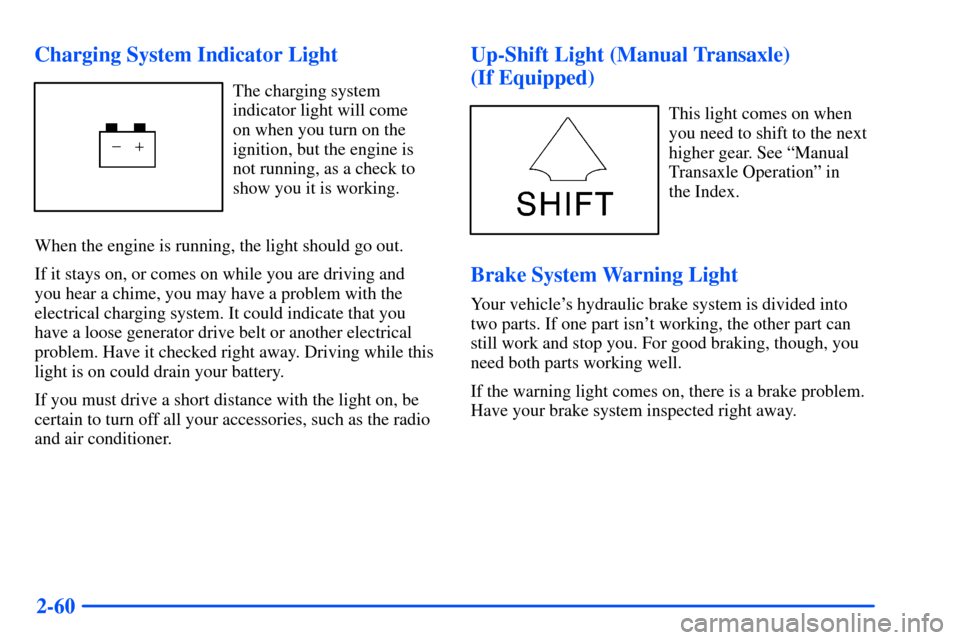
2-60 Charging System Indicator Light
The charging system
indicator light will come
on when you turn on the
ignition, but the engine is
not running, as a check to
show you it is working.
When the engine is running, the light should go out.
If it stays on, or comes on while you are driving and
you hear a chime, you may have a problem with the
electrical charging system. It could indicate that you
have a loose generator drive belt or another electrical
problem. Have it checked right away. Driving while this
light is on could drain your battery.
If you must drive a short distance with the light on, be
certain to turn off all your accessories, such as the radio
and air conditioner.
Up-Shift Light (Manual Transaxle)
(If Equipped)
This light comes on when
you need to shift to the next
higher gear. See ªManual
Transaxle Operationº in
the Index.
Brake System Warning Light
Your vehicle's hydraulic brake system is divided into
two parts. If one part isn't working, the other part can
still work and stop you. For good braking, though, you
need both parts working well.
If the warning light comes on, there is a brake problem.
Have your brake system inspected right away.
Page 131 of 340
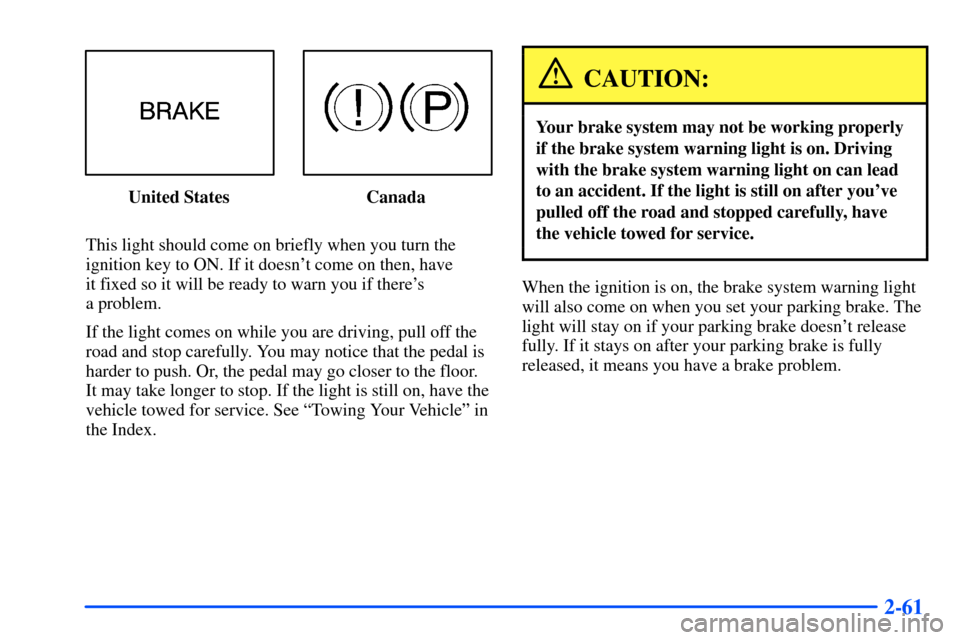
2-61
United States Canada
This light should come on briefly when you turn the
ignition key to ON. If it doesn't come on then, have
it fixed so it will be ready to warn you if there's
a problem.
If the light comes on while you are driving, pull off the
road and stop carefully. You may notice that the pedal is
harder to push. Or, the pedal may go closer to the floor.
It may take longer to stop. If the light is still on, have the
vehicle towed for service. See ªTowing Your Vehicleº in
the Index.
CAUTION:
Your brake system may not be working properly
if the brake system warning light is on. Driving
with the brake system warning light on can lead
to an accident. If the light is still on after you've
pulled off the road and stopped carefully, have
the vehicle towed for service.
When the ignition is on, the brake system warning light
will also come on when you set your parking brake. The
light will stay on if your parking brake doesn't release
fully. If it stays on after your parking brake is fully
released, it means you have a brake problem.
Page 132 of 340
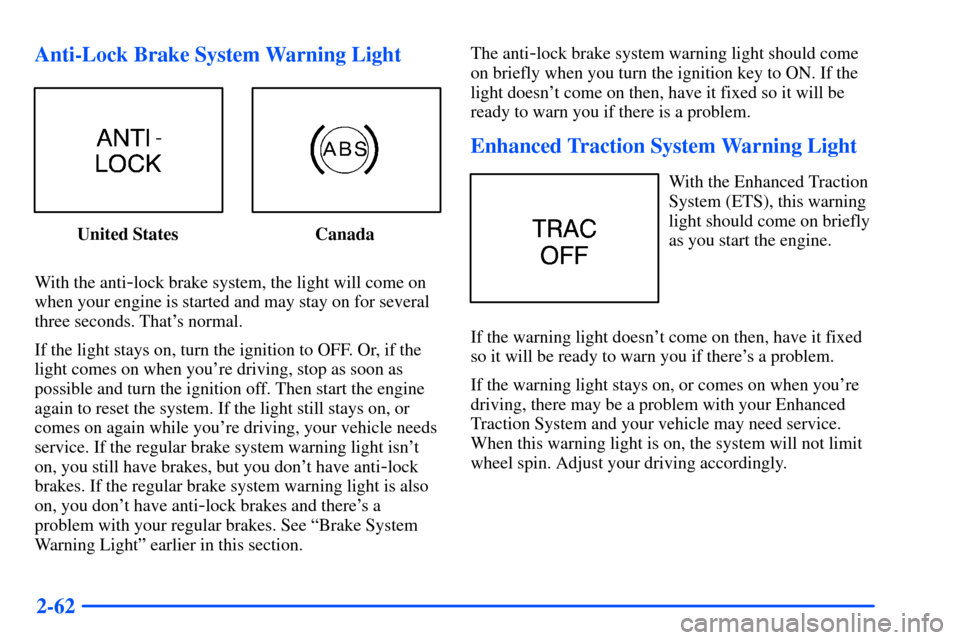
2-62 Anti-Lock Brake System Warning Light
United States Canada
With the anti
-lock brake system, the light will come on
when your engine is started and may stay on for several
three seconds. That's normal.
If the light stays on, turn the ignition to OFF. Or, if the
light comes on when you're driving, stop as soon as
possible and turn the ignition off. Then start the engine
again to reset the system. If the light still stays on, or
comes on again while you're driving, your vehicle needs
service. If the regular brake system warning light isn't
on, you still have brakes, but you don't have anti
-lock
brakes. If the regular brake system warning light is also
on, you don't have anti
-lock brakes and there's a
problem with your regular brakes. See ªBrake System
Warning Lightº earlier in this section.The anti
-lock brake system warning light should come
on briefly when you turn the ignition key to ON. If the
light doesn't come on then, have it fixed so it will be
ready to warn you if there is a problem.
Enhanced Traction System Warning Light
With the Enhanced Traction
System (ETS), this warning
light should come on briefly
as you start the engine.
If the warning light doesn't come on then, have it fixed
so it will be ready to warn you if there's a problem.
If the warning light stays on, or comes on when you're
driving, there may be a problem with your Enhanced
Traction System and your vehicle may need service.
When this warning light is on, the system will not limit
wheel spin. Adjust your driving accordingly.
Page 133 of 340
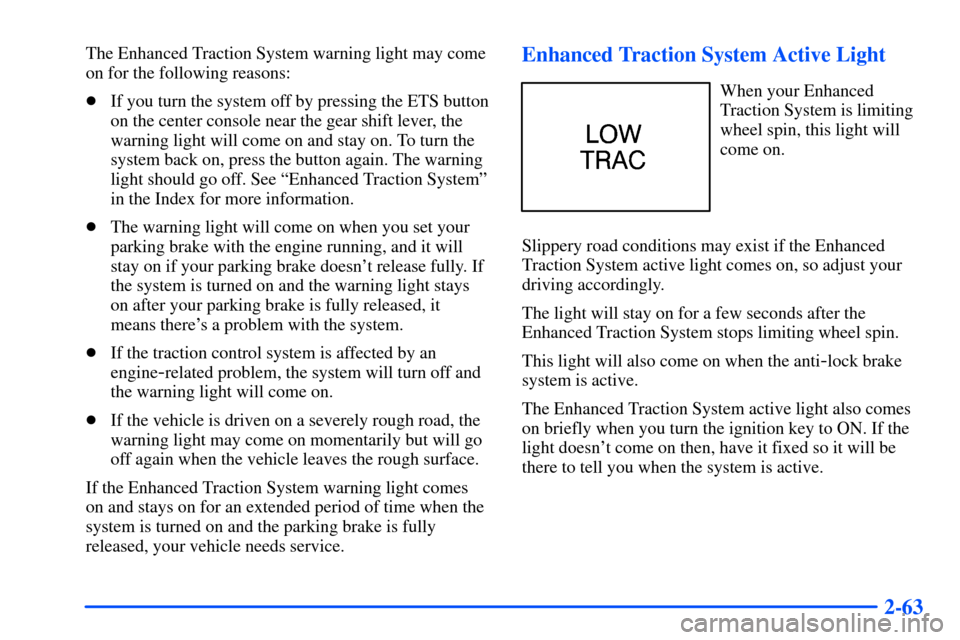
2-63
The Enhanced Traction System warning light may come
on for the following reasons:
�If you turn the system off by pressing the ETS button
on the center console near the gear shift lever, the
warning light will come on and stay on. To turn the
system back on, press the button again. The warning
light should go off. See ªEnhanced Traction Systemº
in the Index for more information.
�The warning light will come on when you set your
parking brake with the engine running, and it will
stay on if your parking brake doesn't release fully. If
the system is turned on and the warning light stays
on after your parking brake is fully released, it
means there's a problem with the system.
�If the traction control system is affected by an
engine
-related problem, the system will turn off and
the warning light will come on.
�If the vehicle is driven on a severely rough road, the
warning light may come on momentarily but will go
off again when the vehicle leaves the rough surface.
If the Enhanced Traction System warning light comes
on and stays on for an extended period of time when the
system is turned on and the parking brake is fully
released, your vehicle needs service.
Enhanced Traction System Active Light
When your Enhanced
Traction System is limiting
wheel spin, this light will
come on.
Slippery road conditions may exist if the Enhanced
Traction System active light comes on, so adjust your
driving accordingly.
The light will stay on for a few seconds after the
Enhanced Traction System stops limiting wheel spin.
This light will also come on when the anti
-lock brake
system is active.
The Enhanced Traction System active light also comes
on briefly when you turn the ignition key to ON. If the
light doesn't come on then, have it fixed so it will be
there to tell you when the system is active.
Page 135 of 340
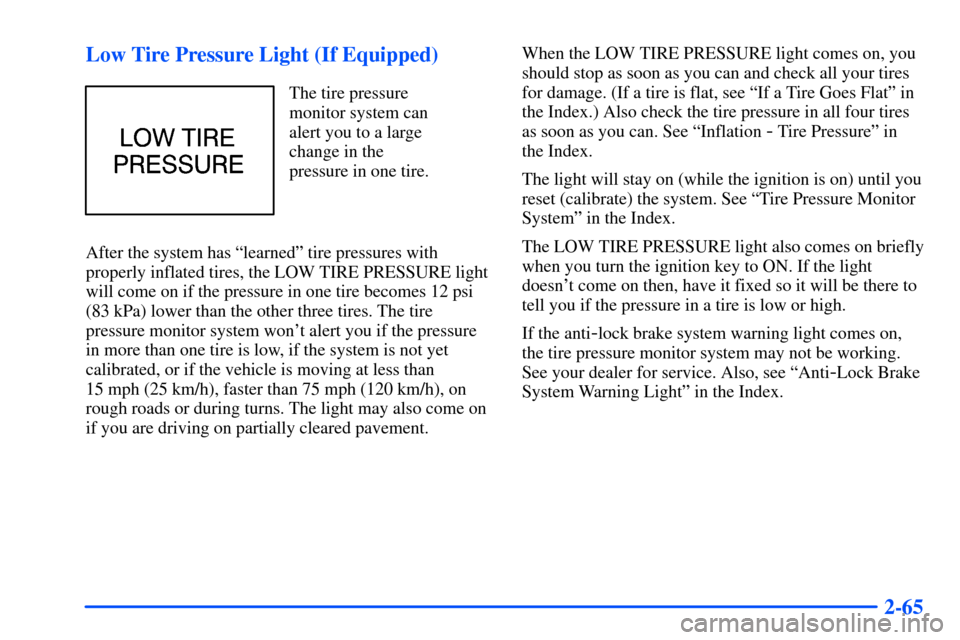
2-65 Low Tire Pressure Light (If Equipped)
The tire pressure
monitor system can
alert you to a large
change in the
pressure in one tire.
After the system has ªlearnedº tire pressures with
properly inflated tires, the LOW TIRE PRESSURE light
will come on if the pressure in one tire becomes 12 psi
(83 kPa) lower than the other three tires. The tire
pressure monitor system won't alert you if the pressure
in more than one tire is low, if the system is not yet
calibrated, or if the vehicle is moving at less than
15 mph (25 km/h), faster than 75 mph (120 km/h), on
rough roads or during turns. The light may also come on
if you are driving on partially cleared pavement.When the LOW TIRE PRESSURE light comes on, you
should stop as soon as you can and check all your tires
for damage. (If a tire is flat, see ªIf a Tire Goes Flatº in
the Index.) Also check the tire pressure in all four tires
as soon as you can. See ªInflation
- Tire Pressureº in
the Index.
The light will stay on (while the ignition is on) until you
reset (calibrate) the system. See ªTire Pressure Monitor
Systemº in the Index.
The LOW TIRE PRESSURE light also comes on briefly
when you turn the ignition key to ON. If the light
doesn't come on then, have it fixed so it will be there to
tell you if the pressure in a tire is low or high.
If the anti
-lock brake system warning light comes on,
the tire pressure monitor system may not be working.
See your dealer for service. Also, see ªAnti
-Lock Brake
System Warning Lightº in the Index.
Page 169 of 340

4-2
Defensive Driving
The best advice anyone can give about driving is:
Drive defensively.
Please start with a very important safety device in your
vehicle: Buckle up. See ªSafety Beltsº in the Index.Defensive driving really means ªbe ready for anything.º
On city streets, rural roads or freeways, it means
ªalways expect the unexpected.º
Assume that pedestrians or other drivers are going to be
careless and make mistakes. Anticipate what they might
do. Be ready for their mistakes.
Rear
-end collisions are about the most preventable of
accidents. Yet they are common. Allow enough
following distance. It's the best defensive driving
maneuver, in both city and rural driving. You never
know when the vehicle in front of you is going to brake
or turn suddenly.
Defensive driving requires that a driver concentrate on
the driving task. Anything that distracts from the
driving task
-- such as concentrating on a cellular
telephone call, reading, or reaching for something on the
floor
-- makes proper defensive driving more difficult
and can even cause a collision, with resulting injury.
Ask a passenger to help do things like this, or pull
off the road in a safe place to do them yourself.
These simple defensive driving techniques could save
your life.
Page 173 of 340
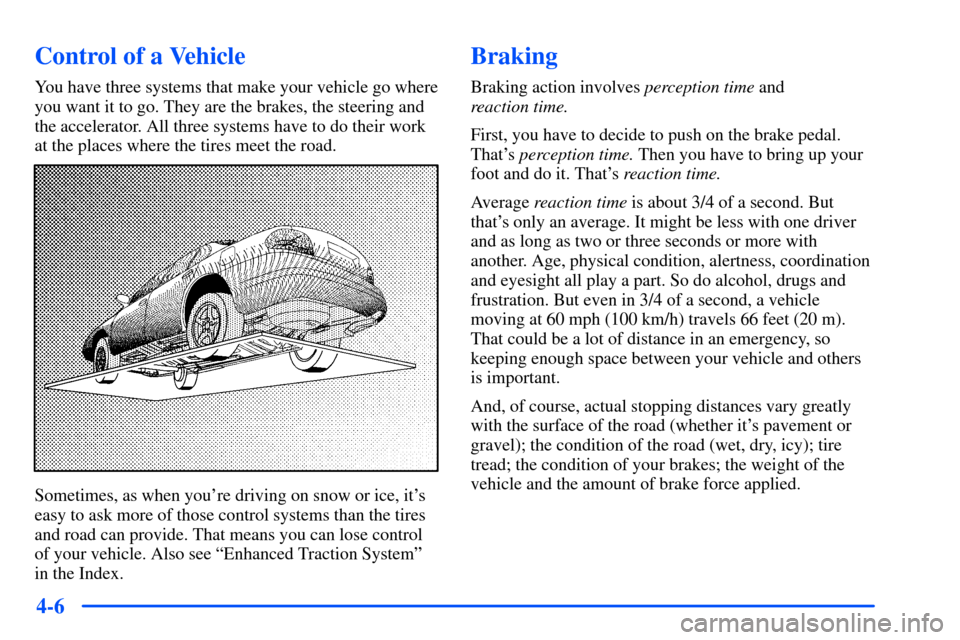
4-6
Control of a Vehicle
You have three systems that make your vehicle go where
you want it to go. They are the brakes, the steering and
the accelerator. All three systems have to do their work
at the places where the tires meet the road.
Sometimes, as when you're driving on snow or ice, it's
easy to ask more of those control systems than the tires
and road can provide. That means you can lose control
of your vehicle. Also see ªEnhanced Traction Systemº
in the Index.
Braking
Braking action involves perception time and
reaction time.
First, you have to decide to push on the brake pedal.
That's perception time. Then you have to bring up your
foot and do it. That's reaction time.
Average reaction time is about 3/4 of a second. But
that's only an average. It might be less with one driver
and as long as two or three seconds or more with
another. Age, physical condition, alertness, coordination
and eyesight all play a part. So do alcohol, drugs and
frustration. But even in 3/4 of a second, a vehicle
moving at 60 mph (100 km/h) travels 66 feet (20 m).
That could be a lot of distance in an emergency, so
keeping enough space between your vehicle and others
is important.
And, of course, actual stopping distances vary greatly
with the surface of the road (whether it's pavement or
gravel); the condition of the road (wet, dry, icy); tire
tread; the condition of your brakes; the weight of the
vehicle and the amount of brake force applied.